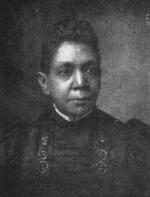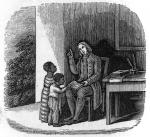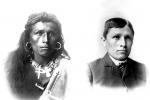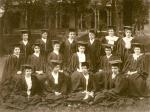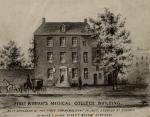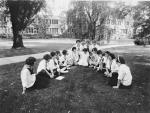Chapter Three: "An Open Field and No Favors": Education and the Quest for Equality
"We should strive to make known to all men the justice of our claim," educator  Fanny Jackson-Coppin said of the role of education in the pursuit of equal opportunity. Though she spoke directly to Pennsylvania's African-American community, Coppin's words applied to any social group denied full and equal participation in American life. In an age of rugged individualism and entrenched cultural stereotypes, struggles for educational opportunity often reflected the gap between cherished ideals and stark social realities. Coppin and other reformers championed education as a pathway to self-improvement and group progress. Education and opportunity were the keys for the disfranchised, Coppin concluded, an "open field" where "no
Fanny Jackson-Coppin said of the role of education in the pursuit of equal opportunity. Though she spoke directly to Pennsylvania's African-American community, Coppin's words applied to any social group denied full and equal participation in American life. In an age of rugged individualism and entrenched cultural stereotypes, struggles for educational opportunity often reflected the gap between cherished ideals and stark social realities. Coppin and other reformers championed education as a pathway to self-improvement and group progress. Education and opportunity were the keys for the disfranchised, Coppin concluded, an "open field" where "no  favors is all that is requested."
favors is all that is requested."
A generation before the creation of the common school system, Pennsylvania's "Poor Laws" (1802, 1804, 1809) committed public funds for a bold social experiment: educating poor children as a way to combat the social and economic effects of poverty. Public-spirited groups and individuals opened schools for children with disabilities, including the Pennsylvania School for the Deaf in 1820, and the Overbrook School for the Blind in 1832. Philadelphia merchant Stephen Girard used his personal fortune to endow Girard "College," a school for orphaned boys that combined sensible academics and apprentice training in the trades.
Stephen Girard used his personal fortune to endow Girard "College," a school for orphaned boys that combined sensible academics and apprentice training in the trades.
Nowhere was the devotion to education as the pathway to broader participation in public life more evident than within Pennsylvania's burgeoning free black population. Even though the Commonwealth had commenced the gradual abolition of slavery in 1780, by the mid-1800s most public and private educational institutions continued to exclude blacks. Even after the creation of common schools, African-American children frequently attended segregated public schools.
Not surprisingly, the Society of Friends in Philadelphia demonstrated early leadership in the creation of schools to educate not only poor but black children as well. Funded by a former slaveholder to prepare African Americans to become skilled laborers and teachers, the Quaker-run Institute for Colored Youth (today's Cheyney University) became one of the nation's most prominent educational institutions dedicated the advancement of the race. Led by principals Ebenezer Don Carlos Bassett (1857-1869) and Fanny J. Coppin (1869-1902), the ICY provided an excellent education for both male and female students, many of whom became community leaders, including ICY teacher and civil-rights activist
Institute for Colored Youth (today's Cheyney University) became one of the nation's most prominent educational institutions dedicated the advancement of the race. Led by principals Ebenezer Don Carlos Bassett (1857-1869) and Fanny J. Coppin (1869-1902), the ICY provided an excellent education for both male and female students, many of whom became community leaders, including ICY teacher and civil-rights activist  Octavius Catto.
Octavius Catto.
Inspired by the growing agitation over slavery and racial inequality, Pennsylvania abolitionists founded other schools for black Pennsylvanians. Some, including Avery College in Pittsburgh (1849) and the Benjamin Banneker Institute in Philadelphia (1854), were short-lived. Founded in 1854 in rural Chester County, the
Avery College in Pittsburgh (1849) and the Benjamin Banneker Institute in Philadelphia (1854), were short-lived. Founded in 1854 in rural Chester County, the  Ashmun Institute (today's Lincoln University) became the nation's first school dedicated to the "scientific, classical, and theological education of coloured [sic] youth of the male sex."
Ashmun Institute (today's Lincoln University) became the nation's first school dedicated to the "scientific, classical, and theological education of coloured [sic] youth of the male sex."
The end of the Civil War may have brought African Americans their freedom, but racial discrimination persisted at all levels of education in Pennsylvania. While a successful legal challenge mandated the desegregation of Pennsylvania's schools in 1881, all-black public schools and segregated teaching persisted for another two generations. Educational inequality has remained a social reality to the present day. Small but growing numbers of African American students did, however, make their way through Commonwealth colleges and professional schools, led by pioneers like Aaron Mossell, who in 1888 became the first African American to graduate from the University of Pennsylvania Law School.
desegregation of Pennsylvania's schools in 1881, all-black public schools and segregated teaching persisted for another two generations. Educational inequality has remained a social reality to the present day. Small but growing numbers of African American students did, however, make their way through Commonwealth colleges and professional schools, led by pioneers like Aaron Mossell, who in 1888 became the first African American to graduate from the University of Pennsylvania Law School.
A young W. E. B. Du Bois conducted research for his path-breaking study, The Philadelphia Negro (1899), with funding from the University of Pennsylvania. Because of racial discrimination, however, even the most highly educated black Pennsylvanians could not teach above the high school level in the Commonwealth. Racial prejudice drove many of the state's most brilliant black students, including Alain Locke, to other states. The son of Philadelphia school teachers, Locke studied abroad as the nation's first African-American Rhodes Scholar, and then taught at the all-black Howard University in Washington D.C.
W. E. B. Du Bois conducted research for his path-breaking study, The Philadelphia Negro (1899), with funding from the University of Pennsylvania. Because of racial discrimination, however, even the most highly educated black Pennsylvanians could not teach above the high school level in the Commonwealth. Racial prejudice drove many of the state's most brilliant black students, including Alain Locke, to other states. The son of Philadelphia school teachers, Locke studied abroad as the nation's first African-American Rhodes Scholar, and then taught at the all-black Howard University in Washington D.C.
Racial prejudice also shaped the schooling of Native Americans. Opened by the federal government in 1879, the Carlisle Indian Industrial School by century's end had become the most famous Indian boarding school in the nation. Under the steady but controversial leadership of Army Captain Richard Henry Pratt, Carlisle combined training in the vocational arts and teacher education to train young Indians to become maids and tradesmen, but not for a higher education. More than 10,000 American Indians attended Carlisle before its closure in 1918, including
Carlisle Indian Industrial School by century's end had become the most famous Indian boarding school in the nation. Under the steady but controversial leadership of Army Captain Richard Henry Pratt, Carlisle combined training in the vocational arts and teacher education to train young Indians to become maids and tradesmen, but not for a higher education. More than 10,000 American Indians attended Carlisle before its closure in 1918, including  Jim Thorpe, the greatest athlete of his era.
Jim Thorpe, the greatest athlete of his era.
In an age when the majority of women had extremely limited professional opportunities, a growing number of Pennsylvanians championed female education to better prepare women for their responsibilities in the home and participated in the creation of all-female educational institutions like the West Chester Female Seminary, and
West Chester Female Seminary, and  Pennsylvania Female College in Harrisburg.
Pennsylvania Female College in Harrisburg.
On the eve of the Civil War, a handful of all-female liberal-arts colleges opened in the Commonwealth. Chartered in 1850 under the sponsorship of the Cumberland Presbyterian Church, Waynesboro College graduated its first female students in 1857. That same year a short-lived female liberal arts college named in honor of author Washington Irving opened in rural Cumberland County. About the same time, Lutherans established the Susquehanna Female College in Selinsgrove, today's Susquehanna University. In western Pennsylvania,
Susquehanna University. In western Pennsylvania,  Wilson College in Chambersburg and Pittsburgh's Pennsylvania Female College (today's Chatham University) were chartered in 1868-9.
Wilson College in Chambersburg and Pittsburgh's Pennsylvania Female College (today's Chatham University) were chartered in 1868-9.
Perhaps the most noteworthy new institution was the Female Medical College of Pennsylvania, which became the nation's first degree-granting medical college for women after it opened its doors in 1850. Within a few years the Female Medical College was attracting women from all over the East who had been barred entry to the University of Pennsylvania Medical College and other prestigious medical schools. The Philadelphia School of Design for Women, which opened in 1852, inspired other design schools across the Commonwealth. (It is worth noting that the nearby
Female Medical College of Pennsylvania, which became the nation's first degree-granting medical college for women after it opened its doors in 1850. Within a few years the Female Medical College was attracting women from all over the East who had been barred entry to the University of Pennsylvania Medical College and other prestigious medical schools. The Philadelphia School of Design for Women, which opened in 1852, inspired other design schools across the Commonwealth. (It is worth noting that the nearby  Pennsylvania Academy of Fine Arts had from its start in 1805 permitted female artists in its studio classes.)
Pennsylvania Academy of Fine Arts had from its start in 1805 permitted female artists in its studio classes.)
Following the example of coeducational normal schools, a growing number of previously all-male colleges began to admit women after the Civil War. By and large, Catholic colleges retained their single-sex identities into the twentieth century, when, for financial reasons, they embraced the gospel of coeducation. Opened in 1869 by Quakers, who had long supported education for girls, Swarthmore College was coeducational from the start. Two decades later, Quakers helped establish the all-female Bryn Mawr College. Under the leadership of progressive educators like M. Carey Thomas and Hilda Worthington Smith, the school became the Commonwealth's pre-eminent all-female college and the first in the nation to offer graduate degrees to women. Bryn Mawr was also able to attract outstanding faculty, including future president Woodrow Wilson.
In the decades that followed, women's educational opportunities expanded in the Commonwealth. In 1910, Bryn Mawr graduate Jane Bowne Haines founded the Pennsylvania School of Horticulture for Women to provide women the practical education they needed to pursue careers in horticulture and landscape architecture. Opened in 1921, the innovative
Pennsylvania School of Horticulture for Women to provide women the practical education they needed to pursue careers in horticulture and landscape architecture. Opened in 1921, the innovative  Bryn Mawr Summer School for Women Workers in Industry became an important but controversial laboratory for the education of female industrial workers and for female labor organizing. Up in the Pocono mountains, the International Ladies' Garment Workers' Union operated
Bryn Mawr Summer School for Women Workers in Industry became an important but controversial laboratory for the education of female industrial workers and for female labor organizing. Up in the Pocono mountains, the International Ladies' Garment Workers' Union operated  Unity House, a vacation and labor education retreat for the families of union members.
Unity House, a vacation and labor education retreat for the families of union members.
During the 1920s and 1930s the historic barriers against women and people of color began to dissolve. The well-established practice of prohibiting married women from teaching and other professions collapsed, and an increasing number of African Americans and women were able to attend many of Pennsylvania's public and private colleges and professional schools. Changing social norms slowly altered the scope of educational opportunities in the Commonwealth. The most revolutionary change in education, however, was yet to come. The passage of the G.I. Bill following World War II and the force of powerful social movements in the 1960s would transform Pennsylvania and American education and the social realities it mirrors.
A generation before the creation of the common school system, Pennsylvania's "Poor Laws" (1802, 1804, 1809) committed public funds for a bold social experiment: educating poor children as a way to combat the social and economic effects of poverty. Public-spirited groups and individuals opened schools for children with disabilities, including the Pennsylvania School for the Deaf in 1820, and the Overbrook School for the Blind in 1832. Philadelphia merchant
Nowhere was the devotion to education as the pathway to broader participation in public life more evident than within Pennsylvania's burgeoning free black population. Even though the Commonwealth had commenced the gradual abolition of slavery in 1780, by the mid-1800s most public and private educational institutions continued to exclude blacks. Even after the creation of common schools, African-American children frequently attended segregated public schools.
Not surprisingly, the Society of Friends in Philadelphia demonstrated early leadership in the creation of schools to educate not only poor but black children as well. Funded by a former slaveholder to prepare African Americans to become skilled laborers and teachers, the Quaker-run
Inspired by the growing agitation over slavery and racial inequality, Pennsylvania abolitionists founded other schools for black Pennsylvanians. Some, including
The end of the Civil War may have brought African Americans their freedom, but racial discrimination persisted at all levels of education in Pennsylvania. While a successful legal challenge mandated the
A young
Racial prejudice also shaped the schooling of Native Americans. Opened by the federal government in 1879, the
In an age when the majority of women had extremely limited professional opportunities, a growing number of Pennsylvanians championed female education to better prepare women for their responsibilities in the home and participated in the creation of all-female educational institutions like the
On the eve of the Civil War, a handful of all-female liberal-arts colleges opened in the Commonwealth. Chartered in 1850 under the sponsorship of the Cumberland Presbyterian Church, Waynesboro College graduated its first female students in 1857. That same year a short-lived female liberal arts college named in honor of author Washington Irving opened in rural Cumberland County. About the same time, Lutherans established the Susquehanna Female College in Selinsgrove, today's
Perhaps the most noteworthy new institution was the
Following the example of coeducational normal schools, a growing number of previously all-male colleges began to admit women after the Civil War. By and large, Catholic colleges retained their single-sex identities into the twentieth century, when, for financial reasons, they embraced the gospel of coeducation. Opened in 1869 by Quakers, who had long supported education for girls, Swarthmore College was coeducational from the start. Two decades later, Quakers helped establish the all-female Bryn Mawr College. Under the leadership of progressive educators like M. Carey Thomas and Hilda Worthington Smith, the school became the Commonwealth's pre-eminent all-female college and the first in the nation to offer graduate degrees to women. Bryn Mawr was also able to attract outstanding faculty, including future president Woodrow Wilson.
In the decades that followed, women's educational opportunities expanded in the Commonwealth. In 1910, Bryn Mawr graduate Jane Bowne Haines founded the
During the 1920s and 1930s the historic barriers against women and people of color began to dissolve. The well-established practice of prohibiting married women from teaching and other professions collapsed, and an increasing number of African Americans and women were able to attend many of Pennsylvania's public and private colleges and professional schools. Changing social norms slowly altered the scope of educational opportunities in the Commonwealth. The most revolutionary change in education, however, was yet to come. The passage of the G.I. Bill following World War II and the force of powerful social movements in the 1960s would transform Pennsylvania and American education and the social realities it mirrors.







